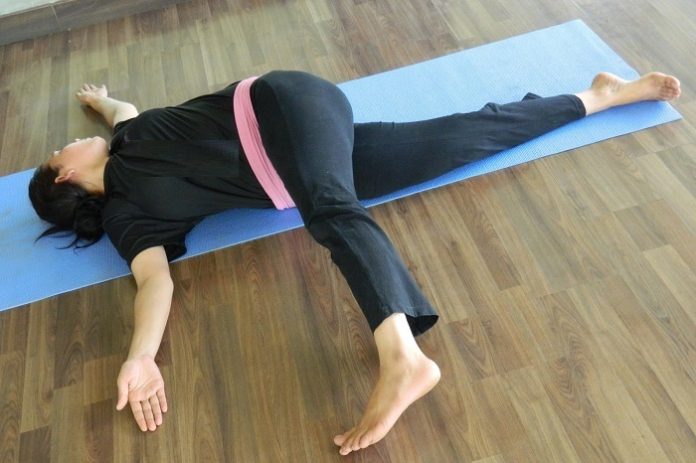Introduction
Markatasana, also known as Monkey Pose, is a yoga posture that requires the practitioner to lie on their back and perform various movements with their legs and hips. The pose is named after the Sanskrit word “markata,” which means monkey. This yoga posture is believed to help improve flexibility, strengthen the lower body, and relieve stress.
“Yoga” means union, and the practice is designed to help people connect with their mind, body, and spirit. Practicing yoga regularly can have many physical and mental health benefits, including increased flexibility, improved posture, reduced stress and anxiety, and enhanced overall well-being.
Also read: 8 Ways to Improve Your Spiritual Health & Wellness
Furthermore, we will discuss variations and modifications of Markatasana to cater to people with different levels of experience, injuries, and disabilities. We will also provide tips on how to incorporate this pose into a regular yoga practice, including sequencing ideas and using props.
Getting to Know Markatasana
Step-by-step guide on how to do Markatasana with illustrations:
- Bend your knees and bring your feet towards your hips, keeping your feet hip-width apart.
- Place your arms on the ground, with your palms facing down and your fingertips pointing towards your feet.
- Inhale and lift your hips off the ground, rolling your spine up one vertebra at a time.
- Bring your hands to your hips and interlace your fingers, pressing your hands into the ground for support.
- Lift your chin towards your chest and roll your shoulders back, lifting your chest towards the sky.
- Stay in the pose for several breaths, then release by exhaling and rolling your spine down one vertebra at a time.
Common mistakes people make while practising Markatasana and how to avoid them:
- Overarching the spine: Avoid arching your spine too much in the pose, as this can strain your lower back. Instead, focus on lifting your hips and chest while keeping your spine neutral.
- Clenching the glutes: Many people tend to clench their glutes in this pose, which can put unnecessary pressure on the lower back. Instead, engage your core muscles and focus on lifting your hips and chest.
- Not supporting the neck: Support your channel by keeping your chin tucked in and your shoulders rolled back.
- Not engaging the legs: Remember to engage your legs by pressing your feet into the ground and lifting your knees towards the sky. This will help strengthen your legs and improve your alignment in the pose.
Safety precautions to keep in mind while performing the pose:
- Avoid this pose if you have any injuries or medical conditions that affect your hips, lower back, or neck.
- If you feel any pain or discomfort in the carriage, leave it immediately and seek guidance from a qualified yoga teacher.
- Always warm up before practising this pose; only force yourself into it if ready.
- Use props such as blankets or blocks to support your hips or back if needed.
Remembering these common mistakes and safety precautions, you can practice Markatasana safely and effectively.
The Benefits of Markatasana
Markatasana, or Monkey Pose, is a yoga posture with numerous physical and mental health benefits. In this section, we will explore the benefits of Markatasana in detail.
Physical Benefits:
- Improved Flexibility: Markatasana stretches the hips, thighs, and lower back muscles, improving overall flexibility. Practising this pose regularly can help to increase your range of motion, making other yoga postures more accessible.
- More Muscular Lower Body: The pose engages and strengthens the muscles of the hips, legs, and core, improving stability and balance. Practising this pose regularly can build strength and endurance in the lower body.
- Better Posture: Markatasana encourages proper spine alignment, improving posture and reducing the risk of back pain. The pose also stretches the chest and shoulders, counteracting the effects of slouching and hunching over.
- Improved Digestion: The twisting motion of Markatasana stimulates the internal organs, improving digestion and reducing bloating and constipation.
Mental Benefits:
- Stress Relief: Markatasana is a relaxing pose that can help to relieve stress and tension. By focusing on the breath and releasing any physical tension in the body, you can create a sense of calm and relaxation.
- Improved Focus: Practicing Markatasana requires concentration and mental focus, which can help to improve cognitive function and mental clarity.
- Enhanced Mood: The physical activity and mindfulness associated with practising yoga, including Markatasana, can release endorphins, which can enhance your mood and reduce symptoms of depression and anxiety.
Explanation of How the Pose Affects Different Parts of the Body:
- Hips: Markatasana stretches the hips, which can help to relieve tension and stiffness in this area. The pose can also improve hip flexibility, making it easier to perform other yoga postures that require open hips.
- Spine: The twisting motion of Markatasana provides a gentle massage to the spine, improving mobility and reducing stiffness. The pose also encourages proper alignment of the spine, which can reduce the risk of back pain and improve overall posture.
- Shoulders: Markatasana stretches the chest and shoulders, which can improve posture and reduce the risk of shoulder injuries. The pose can also relieve upper back and neck tension, reducing pain and stiffness.
Conclusion:
Yoga, in general, is a powerful tool for promoting overall health and wellness. By practising regularly, individuals can improve their physical, mental, and emotional well-being. It is a practice that can be enjoyed by people of all ages and abilities, and with the range of poses and techniques available, there is something for everyone.







